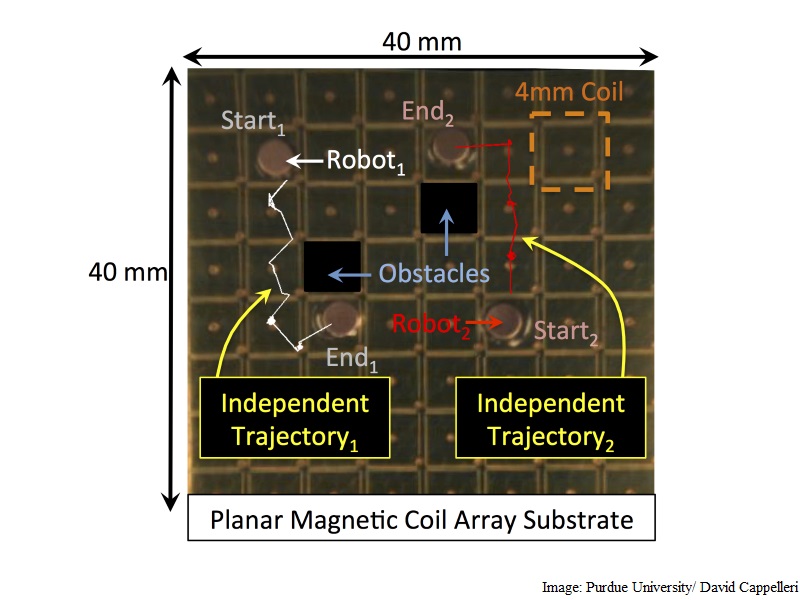- Home
- Science
- Science News
- Microbots Individually Controlled Using 'Mini Force Fields': Study
Microbots Individually Controlled Using 'Mini Force Fields': Study

Until now it was only possible to control groups of microbots to move generally in unison, said David Cappelleri, an assistant professor of mechanical engineering at Purdue University in US.
"We want to be able to control them individually so we can have some robots here doing one thing, and some robots there doing something else at the same time," Cappelleri said.
The team developed a system for controlling the robots with individual magnetic fields from an array of tiny coils.
"The robots are too small to put batteries on them, so they can't have onboard power. We use magnetic fields to generate forces on the robots. It's like using mini force fields," Cappelleri said.
The microbots are magnetic disks that slide across a surface.
While the versions studied are around 2 millimetres in diameter - about twice the size of a pinhead - researchers aim to create microbots that are around 250 microns in diameter, or roughly the size of a dust mite.
In previous systems the microbots were controlled using fewer coils located around the perimeter of the "workspace" containing the tiny machines.
However, this global field is not fine enough to control individual microrobots independently.
"The approach we came up with works at the microscale, and it will be the first one that can give truly independent motion of multiple microrobots in the same workspace because we are able to produce localised fields as opposed to a global field," Cappelleri said.
"What we can do now, instead of having these coils all around on the outside, is to print planar coils directly onto the substrate," he said.
Independently controlled microbots working in groups might be useful in building microelectromechanical systems, or MEMS, minuscule machines that could have numerous applications from medicine to homeland security.
"We might use them for cell sorting, cell manipulation, characterisation and so on. You could think about putting the microcoils on the bottom of a petri dish," Cappelleri said. Microbots equipped with probe-like "force sensors" might then be used to detect cancer cells in a biopsy.
"Cancer cells have different stiffness characteristics than non-cancer cells, and in some of our previous work we put force sensors on the end of these robots to figure out which ones are stiffer than others," Cappelleri said.
The coils were made by printing a copper pattern with the same technology used to manufacture printed circuit boards.
They can be scaled down from their current size of about 4 millimetres. A new process was needed to create a microscale prototype, he said.
The study was published in the journal Micromachines.
Get your daily dose of tech news, reviews, and insights, in under 80 characters on Gadgets 360 Turbo. Connect with fellow tech lovers on our Forum. Follow us on X, Facebook, WhatsApp, Threads and Google News for instant updates. Catch all the action on our YouTube channel.
- Samsung Galaxy Unpacked 2025
- ChatGPT
- Redmi Note 14 Pro+
- iPhone 16
- Apple Vision Pro
- Oneplus 12
- OnePlus Nord CE 3 Lite 5G
- iPhone 13
- Xiaomi 14 Pro
- Oppo Find N3
- Tecno Spark Go (2023)
- Realme V30
- Best Phones Under 25000
- Samsung Galaxy S24 Series
- Cryptocurrency
- iQoo 12
- Samsung Galaxy S24 Ultra
- Giottus
- Samsung Galaxy Z Flip 5
- Apple 'Scary Fast'
- Housefull 5
- GoPro Hero 12 Black Review
- Invincible Season 2
- JioGlass
- HD Ready TV
- Laptop Under 50000
- Smartwatch Under 10000
- Latest Mobile Phones
- Compare Phones
- Redmi Note 15 5G
- Redmi Note 15 Pro 5G
- Redmi Note 15 Pro+ 5G
- Lava Play Max
- Poco C85 5G
- Honor Magic 8 Lite
- Jolla Phone
- Realme P4x 5G
- Asus ProArt P16
- MacBook Pro 14-inch (M5, 2025)
- OnePlus Pad Go 2
- Poco Pad M1
- Just Corseca Skywatch Pro
- Honor Watch X5
- Acerpure Nitro Z Series 100-inch QLED TV
- Samsung 43 Inch LED Ultra HD (4K) Smart TV (UA43UE81AFULXL)
- Asus ROG Ally
- Nintendo Switch Lite
- Haier 1.6 Ton 5 Star Inverter Split AC (HSU19G-MZAID5BN-INV)
- Haier 1.6 Ton 5 Star Inverter Split AC (HSU19G-MZAIM5BN-INV)












